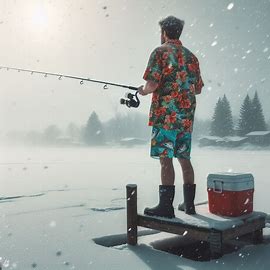Cold-Weather Kayaking presents a unique set of challenges that demand careful consideration of safety and comfort. One of the key aspects often overlooked by novice kayakers is the importance of clothing that doesn’t absorb water. In this article, we will delve into the reasons why water-repellent clothing is crucial for cold-weather kayaking and explore various materials that keep you warm even when wet. Additionally, we’ll provide insights into the types of clothing essential for a kayaker to brave the cold waters while ensuring optimal warmth and safety.
The Dangers of Water-Absorbing Clothing in Cold Weather Kayaking
Before we explore the benefits of water-repellent clothing, let’s understand why wearing garments that absorb water is a potential hazard in cold-weather kayaking. Cold water conducts heat away from the body much faster than cold air, and when clothing becomes saturated, it can exacerbate heat loss.
- Hypothermia Risk: When water-absorbing clothing becomes wet, it can lead to a rapid drop in body temperature, increasing the risk of hypothermia. Hypothermia occurs when the body loses heat faster than it can produce it, and it can set in quickly in cold water conditions.
- Reduced Insulation: Wet clothing loses its insulating properties, leaving the kayaker vulnerable to the chilling effects of the cold water. This can result in a loss of dexterity, impaired decision-making, and diminished physical capabilities, all of which are critical when navigating through challenging water conditions.
Materials That Keep You Warm Even When Wet

Choosing the right materials for kayaking gear is paramount to staying warm in cold conditions, even if your clothing gets wet. Here are some materials known for their water-resistant and insulating properties:
- Neoprene: Neoprene is a popular material for kayaking wetsuits. It is a synthetic rubber that provides excellent insulation and retains its insulating properties even when wet. Neoprene wetsuits come in various thicknesses, offering different levels of warmth to suit varying water temperatures.
- Merino Wool: Merino wool is a natural fiber known for its excellent insulation properties. Unlike traditional wool, merino wool is finer and softer, making it comfortable to wear. Importantly, it retains its insulating capabilities even when wet, making it an ideal choice for base layers and socks.
- Polyester and Polypropylene: These synthetic materials are hydrophobic, meaning they repel water. They are commonly used in thermal layers and base layers for kayakers. These fabrics wick moisture away from the body, keeping you dry and warm.
- GORE-TEX: GORE-TEX is a waterproof and breathable material often used in outer layers, such as jackets and pants. It allows perspiration to escape while preventing water from entering, keeping you dry and comfortable in various weather conditions.
Essential Warm Clothing for Cold-Weather Kayaking

Now that we understand the importance of water-repellent materials, let’s explore the essential warm clothing items every kayaker should have when facing cold temperatures:
- Wetsuit: A wetsuit is a foundational piece of gear for cold-weather kayaking. It provides thermal insulation by trapping a thin layer of water between the suit and the body, which then warms up and acts as an additional insulating barrier.
- Dry Suit: A dry suit is a watertight garment that completely seals the kayaker from water exposure. Unlike a wetsuit, a dry suit does not allow water to enter, keeping the body dry and warm. It is an excellent choice for extremely cold conditions.
- Base Layers: Invest in high-quality base layers made from materials like merino wool, polyester, or polypropylene. These layers wick moisture away from the skin, maintaining warmth and preventing the chilling effects of sweat.
- Insulating Layers: Insulating layers, such as fleece jackets or vests, provide an additional barrier against the cold. Fleece, in particular, is known for its warmth and quick-drying properties.
- Waterproof Outer Layers: Outer layers, like jackets and pants made from GORE-TEX or similar materials, protect against wind, rain, and splashes. These garments should be breathable to prevent overheating and moisture buildup inside.
- Gloves and Pogies: Protecting your hands is crucial in cold conditions. Neoprene gloves or gloves with waterproof membranes can keep your hands warm. Pogies, which cover the hands and paddle shaft, are another excellent option for kayakers.
- Booties or Neoprene Socks: Feet are susceptible to cold, especially in water. Neoprene booties or socks provide insulation and protection against cold water, ensuring your feet stay warm during your kayaking adventure.
- Headgear: A significant amount of heat is lost through the head, so wearing a neoprene hood or a beanie made from insulating materials can help retain warmth. Additionally, a hat with a brim can protect against sun and rain.
Conclusion
In conclusion, dressing appropriately for cold-weather kayaking is not only about staying dry but also about choosing clothing that doesn’t compromise insulation when wet. Water-repellent materials like neoprene, merino wool, polyester, and GORE-TEX play a crucial role in keeping kayakers warm and safe in cold conditions.
Investing in a combination of wetsuits, dry suits, base layers, insulating layers, waterproof outer layers, gloves, booties, and headgear ensures a comprehensive approach to cold-weather kayaking attire. Prioritizing safety, comfort, and performance will enhance the overall kayaking experience, allowing enthusiasts to enjoy the beauty of cold waters without compromising their well-being. Remember, being adequately prepared and dressed in the right gear is the key to unlocking the full potential of cold-weather kayaking adventures.

